If you’re looking to elevate your racing experience in 2025, you’ll want to contemplate the top drone models that blend speed, agility, and performance. Each drone brings unique features that cater to different skill levels and preferences. Whether you’re a beginner or an experienced pilot, the options are impressive. So, which models stand out in this competitive landscape, and what should you keep in mind when making your choice?
Drone Obstacle Course with 3 Pack Easy to Build Hoops
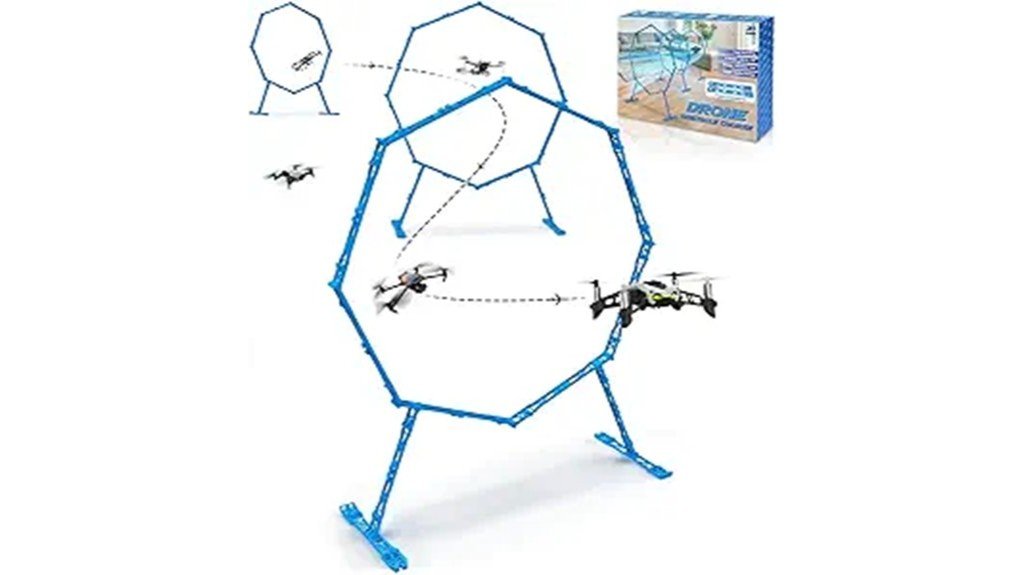
If you’re an FPV racing enthusiast looking to elevate your skills or introduce the thrill of racing to younger pilots, the Drone Obstacle Course with its 3 easy-to-build hoops is the perfect choice. Designed for ages 6-12 and adults, this course enhances your flying skills while providing a fun way to compete. Each hoop is crafted from durable materials, ensuring they withstand intense racing action. With a simple setup guide, you can quickly assemble and disassemble the course, making it portable for outdoor adventures. Configure 3-loop racing routes and enjoy exciting drone racing wherever you go!
Best For: FPV racing enthusiasts of all ages, particularly those aged 6-12, looking to improve their flying skills and compete in exciting races.
Pros:
- Durable Materials: Made from high-quality materials that can withstand intense racing action.
- Easy Setup: Quick assembly with a step-by-step guide, making it accessible for beginners and experienced pilots alike.
- Portable Design: Easily disassembled and transported, perfect for outdoor racing adventures.
Cons:
- Limited Number of Hoops: The course includes only 3 hoops, which may limit the complexity of racing setups.
- Age Restriction: Primarily designed for ages 6-12, may not fully engage older or more experienced pilots.
- Weather Dependency: Outdoor use may be affected by weather conditions, limiting racing opportunities.
Galvanox Drone Obstacle Course Kit for RC FPV Racing
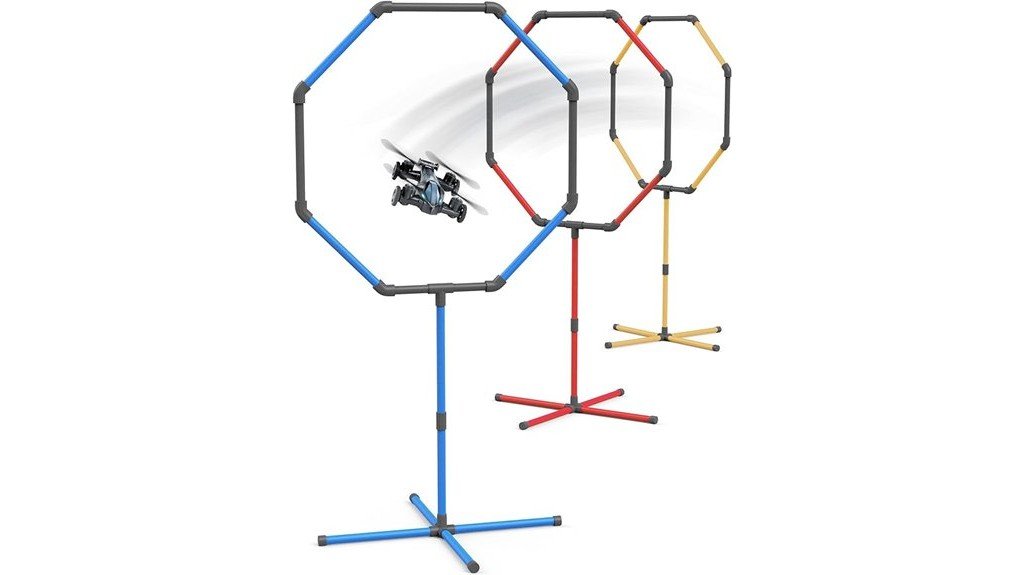
The Galvanox Drone Obstacle Course Kit is perfect for older kids and teens enthusiastic to plunge into the exciting world of RC FPV racing. This kit includes three easy-to-build hoops in varying sizes (20, 23, and 27 inches), allowing you to customize your racing experience. Constructed from stable, weatherproof PVC, it’s designed for durability and easy assembly. With an average rating of 3.7 stars, users enjoy its training potential, though some mention assembly challenges. You might want to add stakes for stability outdoors. Overall, it’s a fun way to sharpen your drone skills while enjoying friendly competition.
Best For: The Galvanox Drone Obstacle Course Kit is best for older kids and teens who are eager to explore the realm of RC FPV racing.
Pros:
- Easy to assemble and disassemble, making setup quick and convenient.
- Durable, weatherproof PVC construction ensures longevity and stability.
- Adjustable difficulty with varying hoop sizes enhances the training experience.
Cons:
- Some users report quality control issues that may affect product performance.
- Assembly complexity can be challenging for beginners.
- The included stopwatch may not meet user expectations; some prefer using stakes for better stability.
APEX FPV Drone Kit for Beginners
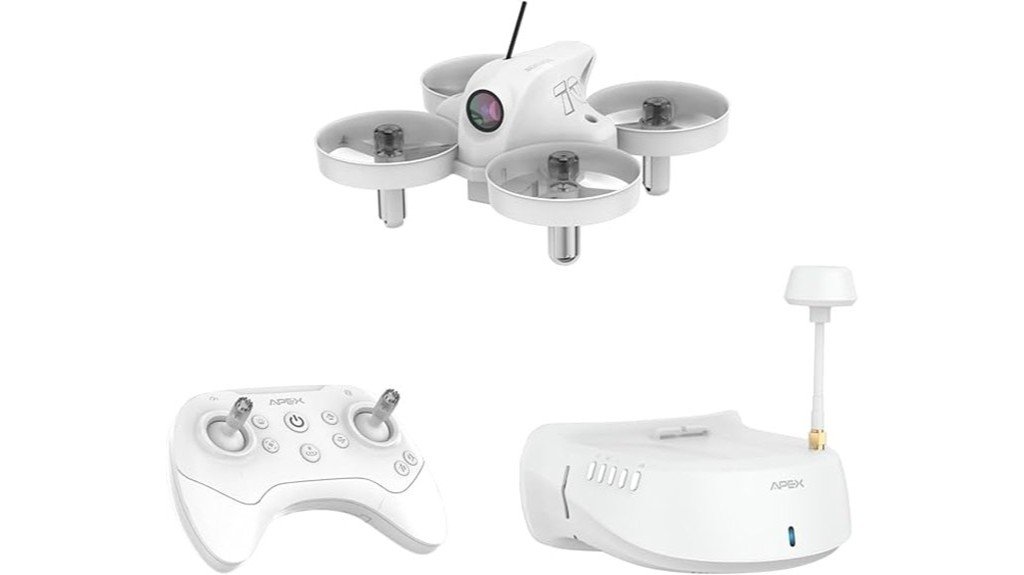
Designed specifically for beginners, the APEX FPV Drone Kit (Model VR70) offers an accessible entry point into the exciting world of FPV racing. Weighing just 100 grams, this brushed drone features low-latency 5.8G transmission and a drop-resistant design. You’ll enjoy a VR immersive flight with FPV goggles and a 120° view. Choose between Manual Mode for freestyle flying or the Beginner Mode, which stabilizes the drone for easier control. With three rechargeable batteries, you’ll get 15-18 minutes of flight time. Plus, it’s compatible with various simulators, making it perfect for honing your skills before hitting the track!
Best For: Beginners looking to explore FPV racing with an easy-to-use and immersive drone experience.
Pros:
- VR Immersive Flight: Equipped with FPV goggles for a real-time and engaging flying experience.
- User-Friendly Modes: Features both Manual and Beginner Modes to cater to different skill levels.
- Good Flight Time: Comes with three rechargeable batteries, providing a total flight time of 15-18 minutes.
Cons:
- Limited Video Resolution: The video capture resolution is only 480p, which may not satisfy advanced users.
- Weight Restrictions: At 100 grams, it may be less stable in windy conditions compared to heavier models.
- Customer Ratings: Holds a moderate customer review score of 3.8 out of 5 stars, indicating some dissatisfaction among users.
Tiny Hawk Freestyle 2 Micro Racing FPV Drone
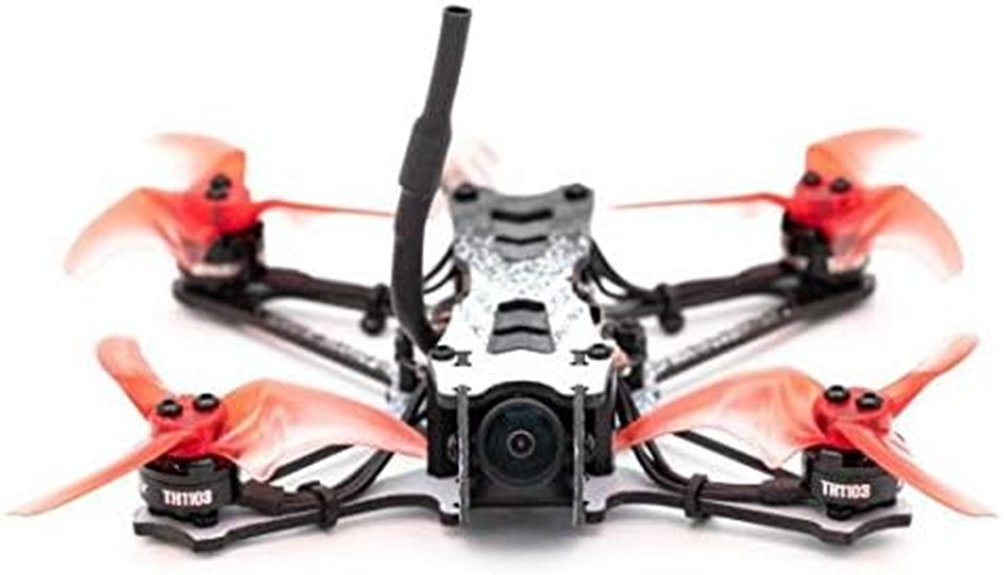
For those seeking an agile and compact racing experience, the Tiny Hawk Freestyle 2 Micro Racing FPV Drone stands out with its lightweight carbon fiber frame and nimble 2.5-inch size. Weighing just 8.1 ounces, it’s perfect for tight spaces and quick maneuvers. You’ll enjoy 720p video capture and reliable FRSKY D8 compatibility. The included 250mAh batteries provide ample flight time, while the optical flow sensor enhances stability. Although some users mention video transmission quality issues, its impressive handling makes it a favorite for indoor racing. With a 30-day return guarantee, you can confidently give this drone a try!
Best For: The Tiny Hawk Freestyle 2 Micro Racing FPV Drone is best for enthusiasts looking for a compact and agile drone for indoor racing in tight spaces.
Pros:
- Impressive handling, making it ideal for racing.
- Lightweight carbon fiber frame enhances maneuverability.
- Includes two 250mAh batteries for extended flight time.
Cons:
- Video transmission quality may not meet expectations.
- Average customer rating of 3.6 out of 5 stars.
- Limited operating temperature range (14°F).
Drones for Kids 8-12 Mini RC Quadcopter & Car
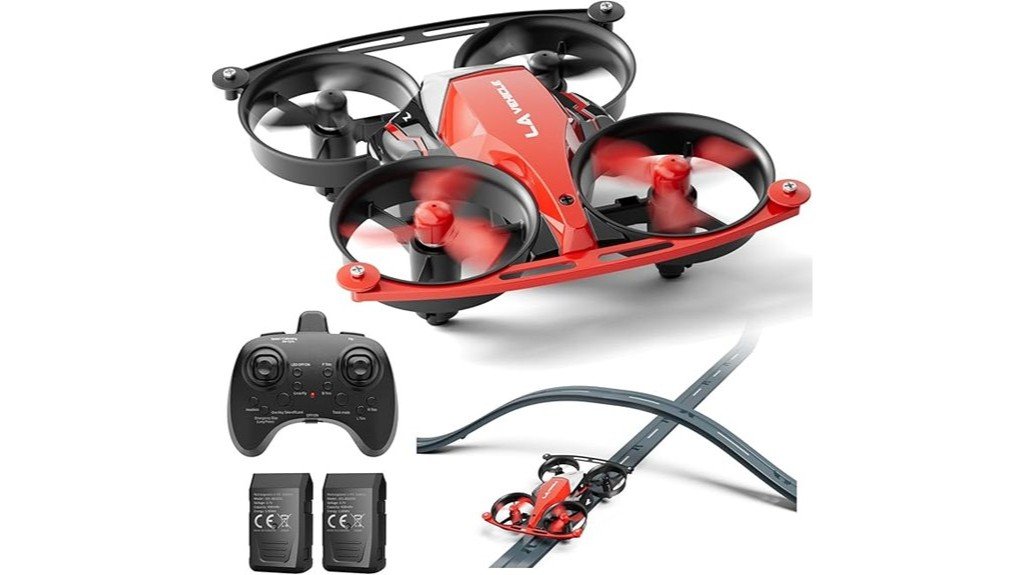
Ideal for kids aged 8 to 12, the SPINORBITOR H4827 Mini RC Quadcopter & Car offers a thrilling 2-in-1 experience that combines the excitement of drone flying with the fun of racing. This compact, 39.5-gram drone features impressive capabilities like 360° flips and jump flying. With 24 track pieces, you can customize your racing courses, while the altitude hold and one-key controls make it easy for beginners. The durable design guarantees safety during play, and the dual-mode functionality keeps kids engaged. With over 18 minutes of flight time, your young pilots will love every minute of their aerial adventures!
Best For: Kids aged 8 to 12 who enjoy both flying drones and racing cars.
Pros:
- Versatile 2-in-1 Design: Functions as both a drone and a racing car, providing varied play options.
- Easy to Use: Features like one-key takeoff/landing and altitude hold make it beginner-friendly.
- Durable and Safe: Designed with propeller protectors and sturdy materials to withstand minor crashes.
Cons:
- Build Quality Concerns: Some users report performance issues and durability decline over time.
- Hovering Difficulty: Beginners may struggle with maintaining stable flight.
- Indoor Use Recommended: Best suited for indoor play or large open areas, limiting where it can be used.
Factors to Consider When Choosing Drones for Racing
When you’re choosing a racing drone, several key factors can make a big difference. You’ll want to take into account weight and size for speed, durability for those intense crashes, and flight time for longer races. Plus, think about how easy it is to set up and the control range to guarantee you stay in the action.
Weight and Size
Choosing the right weight and size for your racing drone can make all the difference in your performance on the track. Lighter models typically offer better speed and agility, allowing for quicker acceleration and improved maneuverability. A compact design is essential, especially when steering through tight spaces or obstacles—micro racing drones around 2.5 inches excel in indoor settings for this reason. Pay attention to the weight-to-power ratio; a well-balanced drone enhances control during those high-speed races. Ultimately, considering both weight and size not only influences your drone’s flying performance but also enriches your overall racing experience and skill development. Make these factors a priority, and you’ll elevate your racing game considerably.
Durability and Materials
Durability is a key factor in selecting a racing drone, as these machines often face the harsh realities of high-speed crashes and intense competition. You’ll want to prioritize high-quality materials like carbon fiber and weatherproof PVC, which enhance structural integrity and longevity. These materials can withstand intense conditions without significant damage, ensuring your drone stays in top shape.
Consider the weight of the materials, too; lightweight yet robust options improve maneuverability while maintaining resilience. Look for drones with reinforced components, such as propeller guards or crash-resistant frames, to protect essential parts during collisions. Ultimately, durable constructions reduce maintenance frequency and increase your drone’s lifespan, making them a more cost-effective choice for racing enthusiasts.
Flight Time Duration
After ensuring your drone’s durability, flight time becomes a top priority for racing enthusiasts. Longer flight times let you practice and compete without constantly swapping batteries. Most entry-level racing drones provide flight times between 10 to 20 minutes, influenced by battery capacity and your flying style. Consider investing in kits with multiple batteries to maximize your flying sessions. However, keep in mind that a drone’s weight, motor efficiency, and environmental conditions can impact flight duration. Heavier setups often result in shorter flights, so balance is key. To stay competitive, monitor and optimize your battery management and flying techniques, ensuring you get the most out of every race. Your ability to manage flight time can be the difference between winning and losing.
Ease of Setup
When it comes to racing drones, ease of setup can greatly enhance your overall experience. Look for obstacle courses that feature effortless setup processes, complete with step-by-step guides tailored for both beginners and seasoned racers. Kits that allow for easy assembly and disassembly are ideal, as they promote quick transportation and simple setups at various locations. Moreover, choose components made from high-quality, durable materials to withstand intense racing action while guaranteeing a straightforward setup. Opt for courses with adjustable difficulty levels, making it easy to modify the setup to match your skills and preferences. Finally, verify the design is portable and compact, allowing for an uncomplicated setup whether you’re racing indoors or outdoors.
Control Range
As you immerse yourself in the world of racing drones, understanding control range is essential for optimizing your performance. Typically, control ranges vary from 1,000 feet to several kilometers, depending on the model and technology. A longer range lets you tackle more extensive tracks and competitive settings, enhancing your racing experience. Key factors affecting control range include the drone’s transmission technology, antenna quality, and potential interference from obstacles or electronic devices. Racing drones often employ low-latency transmission systems, like 5.8GHz, to maintain a stable range and minimize lag. Remember to evaluate your racing environment, as urban areas may present more signal interference compared to open spaces, impacting your control and overall race performance.
Skill Level Suitability
Choosing the right racing drone hinges on your skill level, so it’s crucial to match your experience with the drone’s features. If you’re a beginner, look for models designed for you, featuring altitude hold and easy controls. These drones often come with safety features like propeller guards, making them perfect for younger users aged 6-12. As you gain experience, you might want to shift to intermediate or advanced racing drones that offer customizable settings and require precise control. These models allow you to perform complex maneuvers and compete in challenging environments. Remember, older teens and adults may prefer FPV racing drones, which demand more skill and focus. Always consider assembly complexity, as beginner-friendly drones typically boast straightforward instructions.
Additional Features Offered
While selecting a racing drone, you should consider several additional features that can considerably impact your flying experience and performance. Look for low-latency transmission systems, like 5.8G, which enhance real-time control during races. Lightweight frames, such as carbon fiber, boost agility and speed, giving you an edge on the track. Multiple battery options are essential too, offering extended flight times of 15 to 18 minutes for longer sessions. Advanced features like altitude hold and manual flying modes cater to all skill levels, providing versatile control. Finally, integrated FPV systems with high-resolution video output immerse you in the action, allowing you to navigate courses as if you’re piloting the drone yourself.

